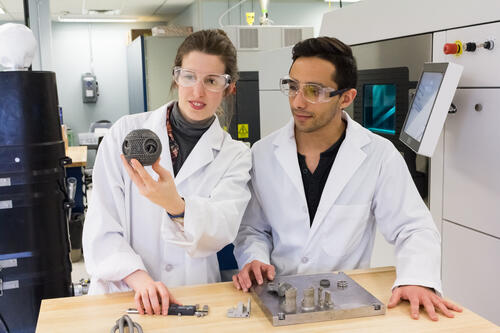The University of Waterloo has announced a joint research and development project with the National Research Council of Canada (NRC) to advance metal 3D printing in Ontario, Canada.
The collaborative effort is set to run for a minimum of seven years, and will provide Canadian manufacturing companies with access to high-end 3D printing equipment and expertise. As such, the partners hope to enable the region of Ontario to adopt and better utilize industrial additive manufacturing in their workflows, increasing competitiveness and operational efficiency.
Mihaela Vlasea, associate director of the Multi-Scale Additive Manufacturing Lab (MSAM) at Waterloo, states, “We want to create in southwestern Ontario a unique ecosystem to support metal additive manufacturing in terms of research and development and to translate competencies to industry partners.”

Building on previous work
Having already worked together for the past three years, the partners will come together once again to advance their research in the fields of process optimization, materials and product characterization, standardized testing, and validation. They have stated plans to use a new NRC facility in Mississauga, which was inaugurated back in November, as a base for the project. The facility is intended as a ‘clean energy hub’, and will be used to facilitate a number of other unrelated projects across 21,500 square feet of laboratories.
Roger Scott-Douglas, acting president of the NRC, explained, “The opening of our new facility in Mississauga represents a major stepping stone for the NRC in advancing Canada’s clean energy agenda. Our vision is for this collaborative hub to become the home to new technologies that will enable industry to be more sustainable. We look forward to working with our partners in accelerating the development of advanced materials technologies and their commercialization into disruptive products for industry.”
Further supporting the partnership, the NRC has also awarded almost $2.6M worth of capital and apparatus to the university as part of its Advanced Manufacturing Supercluster Support program. Splitting the equipment between the new Mississauga facility and the university, the partners will both play a part in also aiding student research.

Making 3D printing economically viable
While the ultimate aim of the partnership is to make metal 3D printing more economically viable for Canadians, the project will be broken down into more focused sub-sections. For example, a major objective is the development of new novel 3D printing powder mixes that use rare and expensive alloys. The researchers will also divert resources to studying powder re-use and recycling, as this can pave the way for more cost-effective production.
Vlasea adds, “I think we can open up new market sectors by empowering people who currently don’t even think about additive manufacturing because their materials don’t exist or they just cost too much.”
Indeed, the team would like to extend metal 3D printing’s use cases to beyond just the common applications in aerospace and medical. By studying powder production in a wide variety of sectors, like the Canadian mining industry, the scientists hope to see the technology employed to a larger extent in oil and gas, automotive, and even nuclear.

Much like the current joint project, the NRC has also previously launched an initiative to advance the research, development and adoption of cold spray additive manufacturing in the country. Together with Quebec-based surface engineering company Polycontrols, the NRC opened a specialized cold spraying facility in February of 2020 to scale the technology for mass production.
In a similar vein, Mohawk College and the University of Guelph recently partnered to develop a novel ductile iron powder mix specifically for metal 3D printing. The material will be used by Ontario-based machined casting supplier CGL Manufacturing to 3D print high-quality prototypes for its clients, increasing the company’s competitiveness with faster lead times.
Subscribe to the 3D Printing Industry newsletter for the latest news in additive manufacturing. You can also stay connected by following us on Twitter and liking us on Facebook.
Looking for a career in additive manufacturing? Visit 3D Printing Jobs for a selection of roles in the industry.
Featured image shows a metal part 3D printed in the MSAM Lab. Photo via MSAM Lab.


